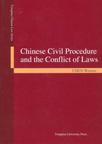中国民事诉讼法与法律冲突法
出版时间:2011-8 出版社:清华大学 作者:陈卫佐 页数:180
内容概要
The manuscript of the present textbook has been used for a
course taught by the author for the LL.M. Program in Chinese Law at
Tsinghua University School of Law from 2005 to 2010. The main
objective of this course is to provide international students with
basic knowledge of Chinese civil procedure and the conflict of
laws. In particular, the course expounds civil lawsuits that are
filed in accordance with the Chinese code of civil procedure (Civil
Procedure Law of the People's Republic of China), other statutes
and judicial interpretations, as well as choice of law rules
determining the law applicable to civil relationships involving
foreign elements. The course provides succinct explanations of
essential issues, fundamental principles and particular
institutions in Chinese civil procedure and the conflict of
laws.The textbook begins with a survey of the Chinese procedural
law and an overview of Chinese civil procedure and then focuses on
essential aspects of court jurisdiction and trial procedure in
civil matters. In view of the traditional importance of alternative
dispute resolution in China, mediation (conciliation) and
arbitration are also discussed with corresponding comparisons to
civil procedure.The textbook also discusses issues relating to the
conflict of laws, i.e. international jurisdiction under the Chinese
international civil procedure law, recognition and enforcement of
foreign judgments as well as Chinese choice of law rules. Focus is
directed toward the Chinese Statute on the Application of Laws to
Civil Relationships Involving Foreign Elements of 28 October 2010,
which entered into force on 1 April 2011.Two appendixes are printed
at the end of the textbook: "Addendtrm 1: Chinese Statutory
Conflict Rules and Conflict Rules Contained in Judicial
Interpretations Prior to 1 April 2011" and "Addendum 2: Statute on
the Application of Laws to Civil Relationships Involving Foreign
Elements of the People's Republic of China" which has been
translated into English jointly by Professr CHEN Weizuo and Mr.
Kevin M. Moore.
作者简介
CHEN Weizuo, Director of the Research Centre for Private International Law and Comparative Law, Tsinghua University School of Law, Beijing, China; Doctor of Laws, Wuhan University, China; LL.M. and doctor iuris, Universitait des Saarlandes,Germany; professeur invite a la Faculte internationale de droit compare de Strasbourg,France (since 2003); professeur invite l'Universit6 de Strasbourg, France (2005-2010); to teach a special course in Frenc.
书籍目录
Part 1 Chinese Civil Procedure
Chapter One A General Survey of Chinese Procedural Law
1. SUBSTANTIVE AND PROCEDURAL LAW
2. DIFFERENT TYPES OF PROCEDURAL LAW
3. JUDICIAL SYSTEM OF THE PRC
Chapter Two An Overview of Chinese Civil Procedure
1. SOURCES OF CHINESE CIVIL PROCEDURAL LAW
2. BASIC PRINCIPLES OF CHINESE CIVIL
PROCEDURE
3. BASIC SYSTEMS OF CHINESE CIVIL
PROCEDURE
Chapter Three Court Competence and Court Jurisdiction in
Civil Matters
1. COURT COMPETENCE IN CIVIL MATTERS AND ITS
RELATIONSHIP TO MEDIATION AND ARBITRATION
2. COURT JURISDICTION
Chapter Four Litigation Participants
1. PARTIES
2. AGENTS AD LITEM
Chapter Five Evidence
1. GENERAL PRINCIPLES
2. BURDEN OF PROOF AND THE COURT'S RIGHT TO
INVESTIGATE AND COLLECT EVIDENCE
3. ORIGINALITY OF EVIDENCE (ARTICLE 68 OF THE
CPL)
4. EXPERT EVALUATION (ARTICLE 72 OF THE
CPL)
5. INSPECTION (ARTICLE 73 OF THE CPL)
6. PRESERVATION OF THE EVIDENCE (ARTICLE 74 OF
THE CPL)
Chapter Six Time Periods and Service
1. TIME PERIODS
2. SERVICE
Chapter Seven Property Preservation and Advance
Execution
1. PROPERTY PRESERVATION
2. ADVANCE EXECUTION
3. RECONSIDERATION
Chapter Eight Compulsory Measures against Obstruction of
Civil Proceedings
1. ACTS OF OBSTRUCTION OF CIVIL PROCEEDINGS AND
COMPULSORY MEASURES AGAINST THEM
2. COMPULSORY MEASURES (DETAILS)
Chapter Nine Litigation Costs
1. MAIN PROVISION OF THE CPL ON LITIGATION
COSTS
2. MEASURES FOR PAYMENT OF LITIGATION
COSTS
Chapter Ten Ordinary Procedure of First Instance
1. BRINGING A LAWSUIT AND ENTERTAINING A
CASE
2. PREPARATION FOR TRIAL
3. TRIAL IN COURT
4. SUSPENSION AND TERMINATION OF LEGAL
PROCEEDINGS
5. JUDGMENT AND ORDER
Chapter Eleven Summary Procedure
1. SCOPE OF APPLICATION
2. PARTIES IN A SUMMARY PROCEDURE
3. OTHER FEATURES
Chapter Twelve Procedure of Second Instance
1. CONDITIONS AND TIME LIMITS FOR AN
APPEAL
……
Part 2 The Conflict of Laws
章节摘录
版权页:B damaged a Sony video projector borrowed from A. A requested compensation of 10,000 yuan RMB from B, but B refused to do so. A sued B in a people's court. The court tried many times to conciliate the dispute between the two parties. A maintained his claim of 10,000 yuan RMB because the original product was available only in Japan whereas B only wanted to compensate 6,000 yuan RMB at most, arguing that the product was already 2 years old. After several months B expressly declared to the court that he did not want to continue the mediation. The court thought that the two parties had been close friends and the object of dispute was not big. It maintained the mediation and postponed the judgment. After another four months, the plaintiffA protested to the court and requested a prompt judgment. The trial judge said to him, "It's quite easy for me to render a judgment, but it will be disadvantageous to you, for you might be compensated merely 5,000 yuan RMB." Question: was that reasonable?Answer: in the instant case, the court conducted mediation on an involuntary basis. It was wrong to do so, because any mediation conducted by a people's court shall be on the voluntary basis (Article 9 of the CPL).
编辑推荐
《中国民事诉讼法与法律冲突法(英文)》是清华中国法系列教材之一。
图书封面
评论、评分、阅读与下载
用户评论 (总计1条)
- GOOD~很明了
